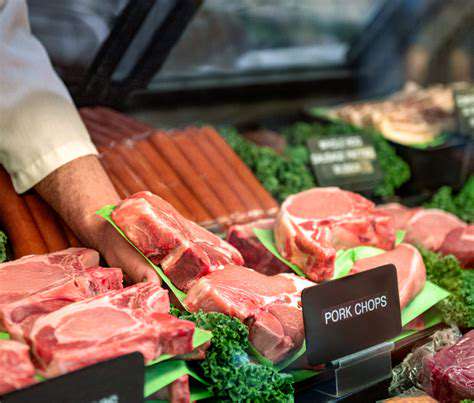Authentic Mexican Street Tacos: Carnitas Recipe
Choosing the Right Pork: Quality is Key

Selecting the Right Cut
When preparing pork dishes, the selection of the right cut makes all the difference between an ordinary meal and an extraordinary one. Each portion of the pig offers distinct qualities that shine under specific cooking techniques. The interplay between fat distribution, muscle grain, and connective tissue determines whether your pork will be fork-tender or disappointingly tough. For quick-cooking methods like pan-searing, leaner cuts such as pork chops excel, while collagen-rich shoulders transform into melt-in-your-mouth perfection during long braises.
Imagine planning a weekend barbecue - you'd want thick, bone-in pork chops that withstand high heat. Alternatively, for taco night, a well-marbled pork shoulder slowly simmered with spices creates irresistible carnitas. The cooking method should dictate your selection as much as personal preference does.
Assessing Quality and Freshness
High-quality pork reveals itself through multiple sensory indicators. The meat should display a rosy pink hue with creamy white fat - any grayish tones or rainbow sheens suggest oxidation. Trust your nose; fresh pork carries a clean, slightly sweet aroma - anything remotely sour or ammonia-like signals trouble. When pressed gently, the flesh should feel firm yet slightly yielding, not sticky or tacky.
Butchers often recommend the three-second rule - if fingerprints remain visible for more than three seconds after touching the meat's surface, it's likely past its prime. Always check sell-by dates, but remember these aren't absolute - your senses provide the most reliable freshness gauge. Don't hesitate to request freshly cut portions if the displayed options seem questionable.
Understanding Different Pork Types
Modern supermarkets typically carry commodity pork, but seeking out heritage breeds can elevate your cooking dramatically. Berkshire (Kurobuta) pork, for instance, contains finer marbling that translates to exceptional juiciness. Farmers raising heritage breeds often employ traditional methods that enhance flavor development, resulting in pork with deeper, more complex taste profiles. Duroc pigs, another prized variety, yield exceptionally tender meat perfect for premium chops.
Regional differences matter too - Spanish Iberico pork from acorn-fed pigs develops nutty undertones, while Mangalitsa pork from Hungary boasts unmatched richness. Exploring these varieties opens new culinary dimensions, allowing home cooks to recreate authentic international dishes with proper ingredients.
Considering Pork's Nutritional Value
As a complete protein source, pork provides all essential amino acids necessary for muscle maintenance and repair. Modern breeding has produced leaner pigs than decades past, with cuts like tenderloin rivaling chicken breast in protein-to-fat ratios. Pork's real nutritional advantage lies in its micronutrients - it's one of the best food sources of thiamine (B1) and contains significant amounts of zinc, selenium, and B vitamins.
Preparation methods dramatically impact healthfulness. Trimming visible fat before cooking reduces calories, while brining maintains moisture without adding excessive sodium. Slow-cooking methods allow flavorful fat to render out rather than being consumed. Understanding these nuances lets health-conscious diners enjoy pork's benefits without compromising dietary goals.
Exploring Pork's Culinary Versatility
Few proteins adapt to global cuisines as readily as pork. It absorbs marinades beautifully in Korean barbecue, crisps perfectly for Italian porchetta, and slow-cooks into falling-apart tenderness for Southern pulled pork. This chameleon-like quality makes pork the ultimate canvas for flavor experimentation, from spicy Szechuan preparations to delicate French charcuterie. Even within a single cuisine, pork offers remarkable range - compare crispy Chinese roast pork belly to delicate wonton fillings.
The texture spectrum alone demonstrates pork's flexibility - it can be pounded paper-thin for schnitzel, ground for sausages, or left in substantial chops for grilling. This adaptability explains why nearly every food culture developed signature pork dishes, each showcasing the meat's incredible range.
The Importance of Proper Storage
Pork's perishability demands careful handling. Refrigerate at 40°F or below, preferably in the coldest section (usually the bottom shelf). For optimal freshness, place pork in a container that catches any juices, preventing cross-contamination while allowing slight airflow - the original packaging often works best for short-term storage. For freezing, double-wrap in moisture-proof materials like heavy-duty foil or freezer bags, pressing out all air to prevent freezer burn.
Different cuts have varying shelf lives - ground pork lasts just 1-2 days refrigerated, while whole roasts may keep 3-5 days. Frozen pork maintains quality for 4-6 months. Always thaw in the refrigerator, never at room temperature, allowing approximately 5 hours per pound. These practices ensure every pork purchase reaches its full potential in your cooking.
- Healthy Meal Prep for Weight Loss: 5 Days of Deliciousness
- Smart Food Storage: Keep Your Groceries Fresh Longer
- Oven Baked Dinners: Less Mess, More Flavor
- Low Carb Breakfast Ideas: Keto Friendly and Satisfying
- Baking Tips and Tricks: Achieve Perfection
- Exploring Vietnamese Cuisine: Flavorful Soups and Noodles
- Grilling Basics: Perfect Burgers Every Time
- Healthy Breakfast Smoothies: Power Packed Blends
- Unveiling Japanese Street Food: Takoyaki and Okonomiyaki
- Low Sugar Meals: Balanced and Flavorful
- Gluten Free Bread Baking: Soft, Chewy, and Delicious
- Low FODMAP Snacks: Gut Friendly Options